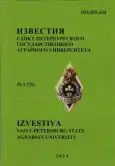Biological Effectiveness of Insecticides Based on Thiamethoxam and Chlorantraniliprole on Apple Tree
- Authors: Anufrieva V.S.1,2, Dolzhenko T.V.1,2, Dolzhenko O.V.3
-
Affiliations:
- Saint-Petersburg State Agrarian University
- Innovation Center for Plant Protection
- All-Russian Research Institute of Plant Protection
- Issue: No 1(75) (2024)
- Pages: 67-76
- Section: Agronomy, forestry and water management
- URL: https://bakhtiniada.ru/2078-1318/article/view/304753
- DOI: https://doi.org/10.24412/2078-1318-2024-1-67-76
- ID: 304753
Cite item
Full Text
Abstract
Today, horticulture is one of the most actively developing and investment-attractive areas of agriculture, which annually demonstrates steady growth. Among the variety of fruit trees, apple is one of the most widespread crops in Russia and in the world. Due to the growing area of its cultivation, there is a growing need to carry out insecticide protection from major pests, otherwise they can not only reduce the quality of fruit and yield, but also lead to a complete loss of yield or even death of plants. The range of insecticides currently used to control pests on apple trees is quite wide, but their main part is represented by preparations belonging to the chemical classes of organophosphorus compounds and pyrethroids, which leads to the emergence of resistance. Based on this, the aim of our research was to study the biological efficacy of pesticides belonging to the classes neonicotinoids and anthranilamides. Treatments included application of insecticide Aktara, VDG during budding period to control apple blossom weevil (Anthonomus pomorum L.) and insecticide Voliam Flexi, SC to control green apple aphid (Aphis pomi Deg.). Spraying was carried out in two application rates. As a result of the experiments, it was found that the use of insecticides led to a decrease in the damage of buds by apple blossom weevil and the number of green apple aphids. The use of insecticide Actara, VDG reduced the number of buds damaged by apple blossom weevil by 92.5% (2021) and 86.8% (2022). Insecticide Voliam Flexi, SC at application rates of 0.4 and 0.5 L/ha provided a reduction in the number of phytophagous plants by 100% (2021) and 73.0% (2022).
About the authors
V. S. Anufrieva
Saint-Petersburg State Agrarian University; Innovation Center for Plant Protection
Author for correspondence.
Email: anufrieva_valera@mail.ru
Postgraduate Student of the Department of Protection and Quarantine of Plants; Junior Researcher Pushkin, St. Petersburg, Russia
T. V. Dolzhenko
Saint-Petersburg State Agrarian University; Innovation Center for Plant Protection
Email: dolzhenkotv@mail.ru
Doc. Sci. (Biol.), Professor of the Department of Protection and Quarantine of Plants; Leading Researcher Pushkin, St. Petersburg, Russia
O. V. Dolzhenko
All-Russian Research Institute of Plant Protection
Email: agrozara86@mail.ru
Cand. Sci. (Biol.), Senior Researcher Pushkin, St. Petersburg, Russia
References
- Danilchuk, A. A., Balykina, E. B., Yagodinskaya, L. P. and Kovalenko, L. V. (2021) “Effectiveness of chemical and biological methods of control with dominant representatives of the Hemiptera on apple trees”, Proceedings of Kuban State Agrarian University, vol. 91., pp. 105⎼109.
- Balakhnina, I.V. and Ivanisova, M.V. (2023) “Aphids in apple orchards, their importance and regulation of numbers”, Plant Protection from pests: Proceedings of the XI International Scientific and Practical Conference, Kuban State Agrarian University named after I.T. Trubilin, Krasnodar, June 19-23, vol. 11, pp. 33⎼35.
- Chernov, V.V. and Podgornaya, M.E. (2020) “Regularities of transformation of dimethoate in apple- tree agrocenoses”, Taurida herald of the agrarian sciences, vol. 2 (22), pp. 180⎼187.
- Dmitrieva, S.V. and Popov, S.Ya. (2019) “Biological Efficacy of Insecticides of Different Classes against Apple Blossom Weevil (Anthonomus pomorum) on Apple Trees”, Zemledelie, vol. 5, p. 45.
- Zeynalov, A.S. (2022) “Features of Anthonomus pomorum L. monitoring on apple and pear trees in climate change conditions”, Vestnik of the Russian agricultural science, vol. 3, pp. 30⎼34.
- Danilchuk, A.A., Balykina, E.B. and Yagodinskaya, L.P. (2022) “Seasonal dynamics of aphid abundance (Hemiptera, Aphidoidеа) in apple orchards of the Crimea” Proceedings of the Kuban State Agrarian University, vol.97, pp. 73⎼77.
- State catalogue of pesticides and agrochemicals approved for use on the territory of the Russian Federation, Moscow, Russia, p. 875.
- Dolzhenko, V.I., Sukhoruchenko, G. I., Burkova L. A., et al. (2021) “Improving the Range of Plant Pest Control Products in Russia in the 21st Century”, Agricultural Chemistry, vol.1, pp. 31⎼40.
- Dolzhenko, T.V., Kozlova, E.G. and Dolzhenko O.V. (2016) “Evaluation of insecticides action on beneficial arthropods”, Russian Agricultural Sciences, vol. 2⎼3, pp. 21⎼23.
- Pooja R. C., Dhanker P, Sushil (2021) “Trends and techniques for thiamethoxam residue estimation in different vegetables and fruits” International Journal of Agricultural Sciences, vol. 17(I2), pp.719⎼723.
- Preeti Dhanker, Sushil, Reena Chauhan Pooja, Rahul Dhanker (2022) “Assessing the degradation pattern of ready premix formulation of chlorantraniliprole + thiamethoxam in canal water under laboratory conditions” The Pharma Innovation Journal, vol. 11(3), pp.1893⎼1897.
- Dolzhenko, V.I., Laptiev, A.B. (2021) “Modern range of plant protection means: biological efficiency and safety”, Plodorodie, vol.3(120), pp. 71⎼75.
- Hongbo Li, Changgeng Dai, Yang Hu (2022) “The Efficacy of Chlorantraniliprole as a Seed Treatment for Mythimna separata (Walker) (Lepidoptera: Noctuidae)” Journal of Chemistry, Article ID 3781567, p. 6. https://doi.org/10.1155/2022/3781567.
- Dolzhenko, V. I., Sukhoruchenko, G. I., Burkova, L. A. et al. (2022) Methodological guidelines for registration tests of insecticides, acaricides, pheromones, molluscicides and rodenticides in crop production, Moscow, FGBNU "Rosinformagroteh", 2022, p. 508.
Supplementary files









